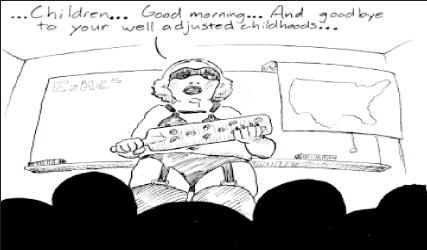For parents, it is legal in 49 states to spank your child, and in 19 states, it is legal for school teachers to spank children. This is unacceptable to helpless children in America; it is time to ban all spanking in the United States.
In a 2005 poll, 77 percent of Americans disapproved of school physical punishment. This makes sense, even to proponents of spanking their own children. If anyone is going to spank their child, it might as well be them.
Even with this massive disapproval of sanctioned school spanking, schools continue to spank their students if it is legal to do so. According to CNN.com, more than 200,000 American children were spanked or paddled in 2006. Most of these spankings occurred in southern states. In Mississippi, 7.5 percent of students were physically punished during school. Even though these numbers are disturbingly high, it’s quite a drop from the more than 340,000 American children spanked during school in 2000.
How is this still legal? I feel ashamed to be a part of a country that pretends barbaric practices from the 20th century should still be relevant in our daily lives.
Tenika Jones’ five-year-old son attended Joyce Bullock Elementary School in Florida. Her son was paddled so badly by a principal that he cried for hours, which led to an emergency room visit because of a subsequent asthma attack. The young boy had welts on his buttocks and still has nightmares stemming from the incident.
If there is anything nowadays that should be bipartisan, it should be making physical punishment in schools by teachers and administrators illegal. There is simply no reason for another person to physically lay their hands on your child.
Making physical punishment in schools illegal is a necessary step, but it isn’t a sufficient one. All spanking must be made illegal in the United States.
Whereas most Americans disapprove of physical punishment in school, the opposite result occurs in regards to spanking children at home. In a 2004 General Social Survey, 71.3 percent of American adults supported physical punishment, down from polls in the 1960s that showed 94 percent of American adults supported physical punishment.
This would explain why, by the time kids reach the fifth grade, 80 percent have been physically punished, according to a report by Elizabeth Gershoff. It also explains why 85 percent of high school students have been physically punished, with 51 percent saying they were hit with a belt or another object.
When a majority of American adults believe it is acceptable to physically punish their children, that is exactly what they’re going to do. But here’s the thing; physically punishing a child is not just morally wrong, it has negative effects on children.
Studies have shown “the association of physical punishment with impairments in children’s mental health, such as anxiety and depression, alcohol and drug use, and general psychological maladjustment.”
I was spanked as a child by one of my parents and it never served any good. It only made me fear that parent as a child. I remember my parents taking my bicycle away, as a five year old, serving the same deterrent effect as a spanking. Except with my bicycle being taken away, I wasn’t physically afraid of the one parent.
I was spanked until I was around five or six years old. Now as a 22-year-old-man, I suffer from a social anxiety disorder and clinical depression. Although I know spanking wasn’t the only cause of those disorders, I know it exacerbated them further.
Spanking also disrupts the relationship between the child and the parent. In 13 studies, physical punishment was associated with “poorer quality of parent-child relationships.” Spanking thus causes parenting to become more difficult, not simpler.
Physical punishment at home creates more physical punishment at home for future families and generations.
When a child is hit, he or she implicitly learns that hitting a person can be justified. If not, why would their parent strike them?
If a child has done nothing too bad, like accidently spilling milk, and a parent hits the child and causes physical and emotional pain, that child is going to eventually ask why it is not acceptable to hurt others for similar reasons. A child might think that it is now acceptable to hit another person for stealing his or her toy.
It’s not acceptable, but to a child, this is the same as being hit for spilling milk.
Children take these lessons, good or bad, with them for the rest of their lives. Research shows that people who were physically punished as a child have a higher chance, “to perpetuate violence on their own family members.” Thus, physical punishment of children leads to more of it in the future.
Physical punishment of children is wrong. It is not legal to hit a prisoner or another person as a private citizen; it should not be legal for an adult to hit a defenseless child.






















